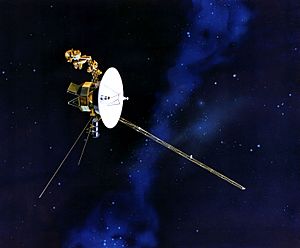Space probe facts for kids

A space probe is a special kind of robot spacecraft. It's sent on a mission without people inside to explore distant places like planets, moons, asteroids, or comets. These amazing machines help us learn about our Solar System and even beyond.
Space probes are like robotic explorers. They can fly past a planet, orbit around it, or even land on its surface. They use radio waves to send pictures and information back to Earth. This helps scientists understand what these faraway places are like. A space observatory is different; it looks at distant objects from far away but doesn't travel close to them.
Contents
Why Do We Send Space Probes?
Space probes are super important for space exploration. They can go to places that are too dangerous or too far for humans to visit right now.
- Learning about planets: Probes help us study the weather, geology, and possible signs of life on other planets.
- Exploring moons and asteroids: They can find out what these smaller objects are made of and if they have water or other resources.
- Understanding our Solar System: By studying different parts of space, probes help us learn how our Solar System formed and changed over billions of years.
- Safety: Sending robots means no human lives are at risk during these long and risky journeys.
How Do Space Probes Work?
Space probes are packed with amazing technology. They have cameras to take pictures, sensors to measure things like temperature and radiation, and special tools to analyze rocks or gases.
- Power: Many probes use solar panels to get energy from the Sun. For missions far from the Sun, like the Voyager probes, they use special nuclear power sources.
- Communication: Probes talk to Earth using powerful radio antennas. It can take minutes or even hours for their signals to reach us, depending on how far away they are.
- Navigation: Scientists on Earth guide the probes carefully. They use complex calculations to make sure the probe reaches its target accurately.
Types of Space Probe Missions
There are different ways space probes explore. Each type of mission helps us gather unique information.
Flyby Missions
A flyby probe travels past a planet or moon without stopping. It takes pictures and gathers data as it speeds by.
- Example: The Voyager 1 and Voyager 2 probes are famous flyby missions. They flew past Jupiter, Saturn, Uranus, and Neptune, sending back the first close-up images of these giant planets. They are now traveling out of our Solar System!
Orbiter Missions
An orbiter probe goes into orbit around a planet or moon. It stays there for a long time, circling its target and studying it from above.
- Example: The Mars Reconnaissance Orbiter has been circling Mars since 2006. It takes detailed pictures of the Martian surface and helps scientists plan future landing sites. The Juno probe is currently orbiting Jupiter, studying its atmosphere and magnetic field.
Lander and Rover Missions
Lander probes touch down on the surface of a planet or moon. Rover probes are landers that can also move around on wheels.
- Example: NASA's Curiosity and Perseverance rovers are exploring Mars. They collect rock and soil samples, drill into the ground, and search for signs of ancient life. The Philae lander even landed on a comet!
Who Sends Space Probes?
Many countries and space agencies around the world work together or separately to send probes into space.
- The United States (NASA)
- The European Union (ESA)
- Russia
- Japan (JAXA)
- China (CNSA)
- India (ISRO)
- Israel
These agencies have launched many probes to different planets and moons in our Solar System. There are about 15 space probe missions still working today, sending back new discoveries all the time!

